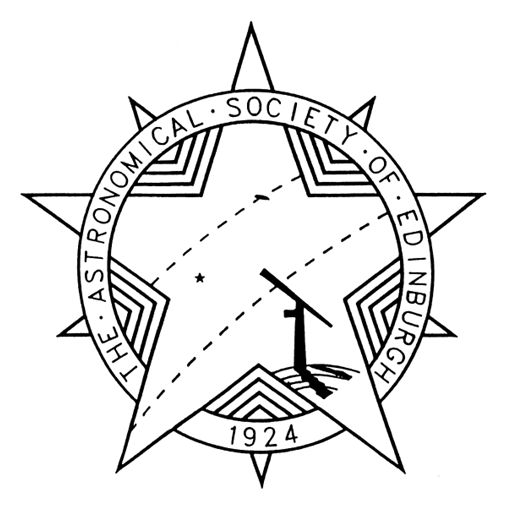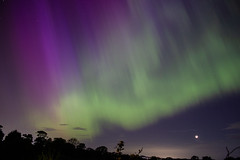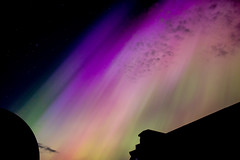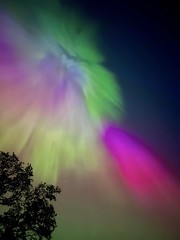Scotland’s Sky in November, 2016
Nights begin with Venus and end at Jupiter

The maps show the sky at 21:00 GMT on the 1st, 20:00 on the 16th and 19:00 on the 30th. An arrow depicts the motion of Mars after the first week of the month. (Click on map to enlarge)
The end of British Summer Time means that we now enjoy six hours of official darkness before midnight, though I appreciate that this may not be welcomed by everyone. The starry sky as darkness falls, however, sees only a small shift since a month ago, with the Summer Triangle, formed by the bright stars Vega, Deneb and Altair, now just west of the meridian and toppling into the middle of the western sky by our star map times.
Those maps show the Square of Pegasus high in the south. The star at its top-left, Alpheratz, actually belongs to Andromeda whose other main stars, Mirach and Almach, are nearly equal in brightness and stand level to its left. A spur of two stars above Mirach leads to the oval glow of the Andromeda Galaxy, M31, which is larger than our Milky Way and, at 2.5 million light years, is the most distant object visible to the unaided eye. It is also approaching us at 225 km per second and due to collide with the Milky Way in some 4 billion years’ time.
Binoculars show M31 easily and you will also need them to glimpse more than a handful of stars inside the boundaries of the Square of Pegasus, even under the darkest of skies. In fact, there are only four such stars brighter than the fifth magnitude and another nine to the sixth magnitude, close to the naked eye limit under good conditions. How many can you count?
Mars is the easiest of three bright planets to spot in tonight’s evening sky. As seen from Edinburgh, it stands 11° high in the south as the twilight fades, shining with its customary reddish hue at a magnitude of 0.4, and appearing about half as bright as the star Altair in Aquila, 32° directly above it.
Now moving east-north-eastwards (to the left), Mars is 5° below-right of the Moon on the 6th and crosses from Sagittarius into Capricornus two days later. Soon after this, it enters the region covered by our southern star map, its motion being shown by the arrow. By the 30th, Mars has dimmed slightly to magnitude 0.6 but is almost 6° higher in the south at nightfall, moving to set in the west-south-west at 21:00. It is a disappointingly small telescopic sight, though, its disk shrinking from only 7.5 to 6.5 arcseconds in diameter as it recedes from 188 million to 215 million km.
We need a clear south-western horizon to spy Venus and Saturn, both low down in our early evening twilight. Venus, by far the brighter at magnitude -4.0, is less than 4° high in the south-west thirty minutes after sunset, while Saturn is 4° above and to its right, very much fainter at magnitude 0.6 and only visible through binoculars. The young earthlit Moon may help to locate them – it stands 3° above-right of Saturn on the 2nd and 8° above-left of Venus on the 3rd.
Mercury is out of sight in the evening twilight and Saturn will soon join it as it tracks towards the Sun’s far side. However, Venus’ altitude thirty minutes after sunset improves to 9° by the 30th when it sets for Edinburgh at 18:30 and is a little brighter at magnitude -4.1. Viewed telescopically, Venus shows a dazzling gibbous disk that swells from 14 to 17 arcseconds as its distance falls from 178 million to 149 million km.
Sunrise/sunset times for Edinburgh change from 07:20/16:31 on the 1st to 08:18/15:44 on the 30th. The Moon reaches first quarter on the 7th, full on the 14th, last quarter on the 21 and new on the 28th.
The full moon on the 14th occurs only three hours after the Moon reaches its perigee, the closest point to the Earth in its monthly orbit. As such, this is classed as a supermoon because the full moon appears slightly (7%) wider than it does on average. By my reckoning, this particular lunar perigee, at a distance of 356,509 km, is the closest since 1948 when it also coincided with a supermoon.
Of the other planets, Neptune and Uranus continue as binocular-brightness objects in Aquarius and Pisces respectively in our southern evening sky, while Jupiter, second only to Venus in brightness, is now obvious in the pre-dawn.
Jupiter rises at Edinburgh’s eastern horizon at 04:28 on the 1st and stands more than 15° high in the south-east as morning twilight floods the sky. It outshines every star as it improves from magnitude -1.7 to -1.8 by the 30th when it rises at 03:07 and is almost twice as high in the south-south-east before dawn.
Currently close to the famous double star Porrima in Virgo, Jupiter is 13° above-right of Virgo’s leader Spica and draws 5° closer during the period. Catch it less than 3° to the right of the waning earthlit Moon on the 25th. Jupiter’s distance falls from 944 million to 898 million km during November while its cloud-banded disk is some 32 arcseconds across.
The annual Leonids meteor shower has produced some stunning storms of super-swift meteors in the past, but probably not this year. Active from the 15th to 20th, it is expected to peak at 04:00 on the 17th but with no more than 20 meteors per hour under a dark sky. In fact, the bright moonlight is likely to swamp all but the brightest of these this year. Leonids diverge from a radiant point that lies within the Sickle of Leo which climbs from low in the east-north-east at midnight to pass high in the south before dawn.
Alan Pickup
This is a slightly-revised version of Alan’s article published in The Scotsman on November 1st 2016, with thanks to the newspaper for permission to republish here.
Posted on 01/11/2016, in Uncategorized and tagged Alan Pickup, Almach, Alpheratz, Andromeda, ASE, Astronomical Society of Edinburgh, Jupiter, Leo, Leonids, M31, Mars, Mercury, Mirach, moon, Neptune, Porrima, Saturn, Spica, Square of Pegasus, Summer Triangle, supermoon, Uranus, Venus, Virgo. Bookmark the permalink. 1 Comment.




Actually in The Scotsman on 2 November! SC